Insights on the Camino de Santiago
My journey from Germany to Portugal took me from Bordeaux to the Atlantic Ocean, on whose shores I crossed the Spanish border. Being on the road became a routine, and with it began the journey into my inner self.
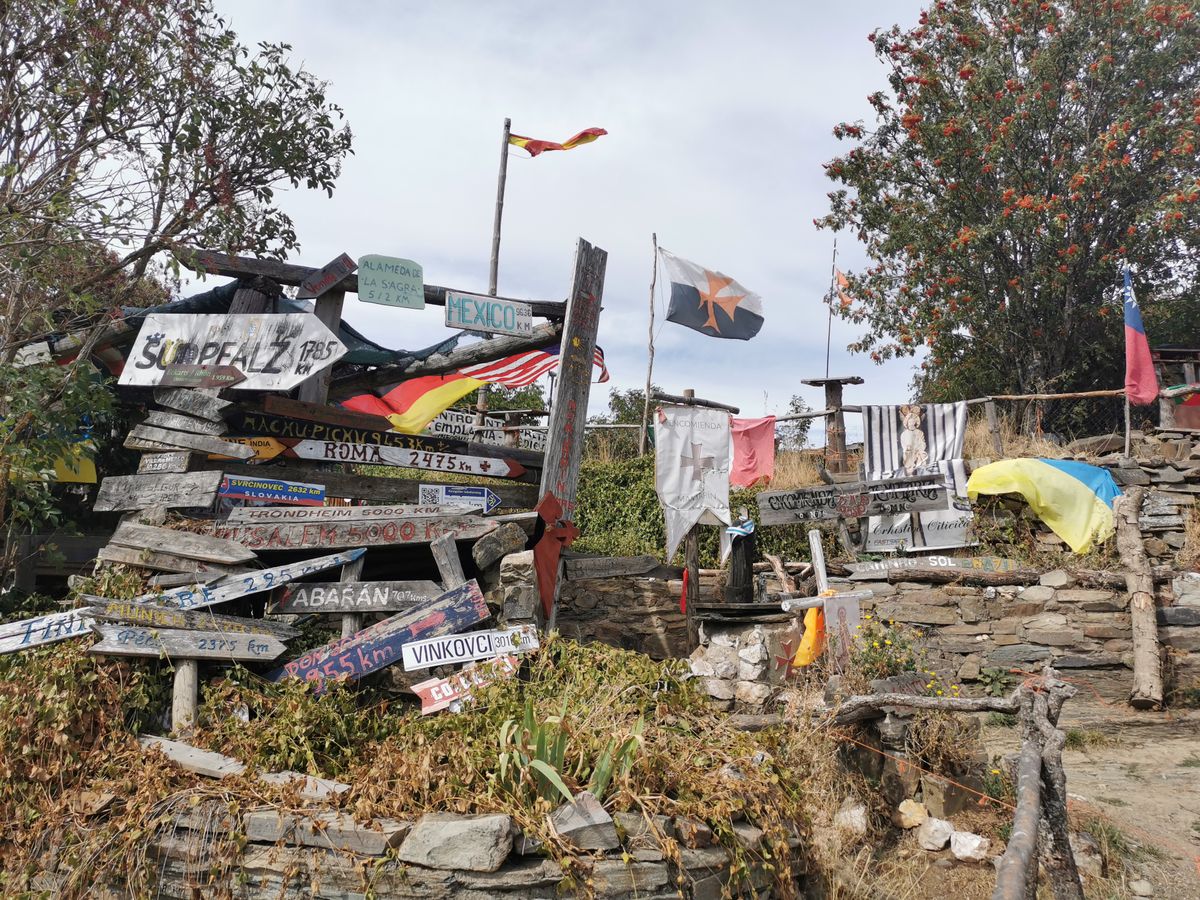
Hier geht es zur deutschen Version
I could hardly wait to get going. Ahead of me lay the Atlantic Ocean - an important milestone on my journey from Germany to Portugal. Over paths drawn in the landscape with a ruler, I was getting closer and closer to my big intermediate destination, having continued my journey from Bordeaux. I was again on the hunt for the horizon. In my mind's eye, I could already see myself sitting in the sun on miles of beaches and throwing myself into the waves to cool off whenever I felt like it. Reality looked different.
I reached the shore of the Atlantic Ocean in Lacanau Océan. Instead of empty beaches, I found a place on the ocean covered by a carpet of people. Lacanau was the opposite of what I imagined. It was like being in an amusement park full of lights and sounds that were only there to attract my attention and drain me of money. A few kilometers further on, it became quieter, but the romantic beach atmosphere I was hoping for failed to materialize. Between the bike path in the pine forests and the actual beach lay wide dune landscapes, so I rarely got to see the sea. In addition, the sand and pretty much all the moving parts of my bike didn’t get along too well. The crunching and cracking in my chain still causes me pain when I think about it. After a while, I got used to the idea that this part of my trip would be different than I had imagined.
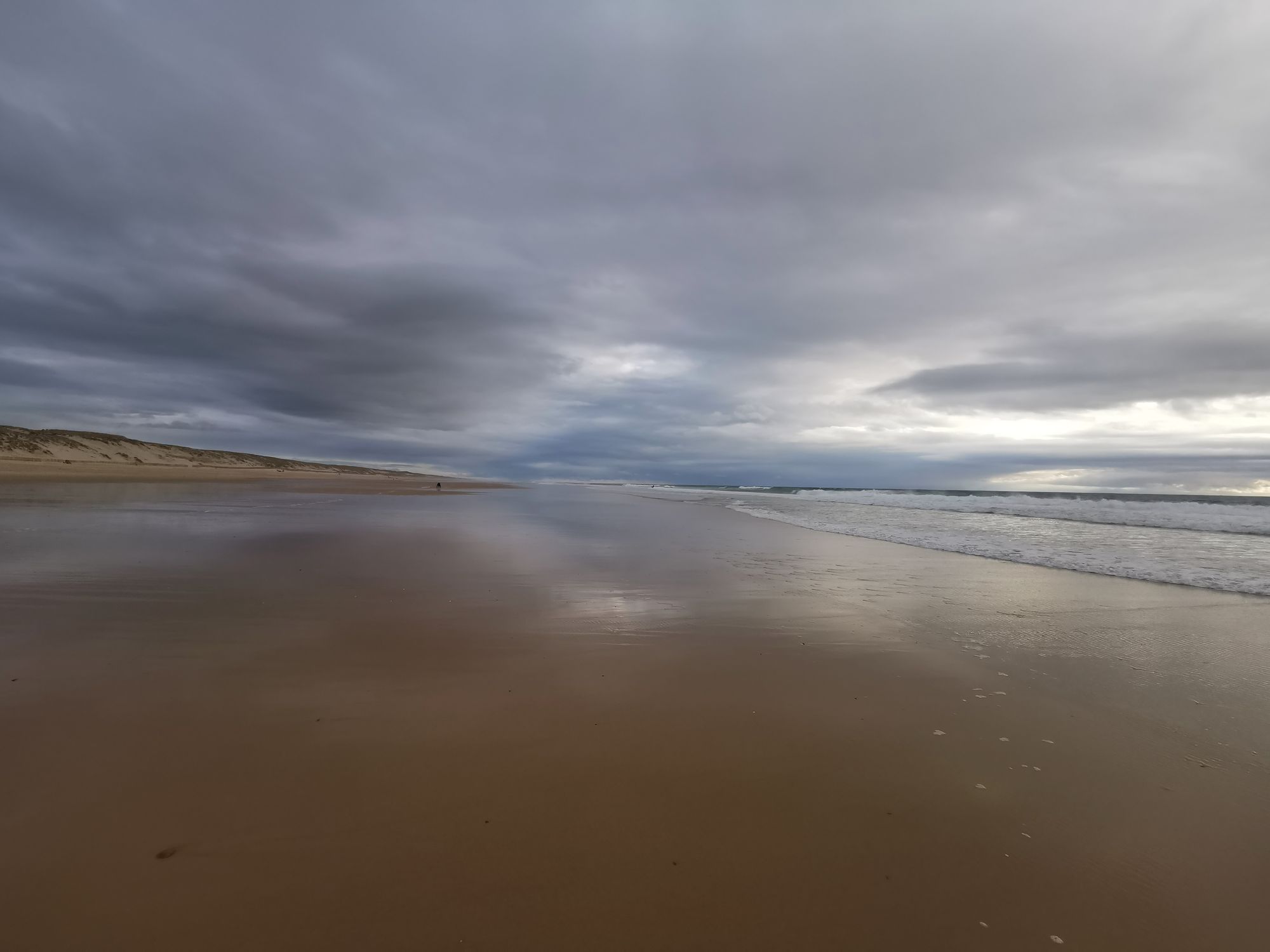
What I couldn't get used to were the effects of the forest fires. My worst fears did not come to pass. I wasn't surprised by the fires or trapped by them on a remote forest trail. I only had to adjust my route slightly to avoid restricted areas. Instead, I arrived when everything was already over. What was left were the desolate remains of a catastrophe. Miles of scorched earth and charred trees, always accompanied by the sour smell of wet ash. After a short time, I came to Dune du Pilat, the largest sand dune in Europe. Here, too, the forest fires were still raging a few days before my arrival. But instead of concerned people, I met tourists there, who were by no means affected by the fires. With absurd exuberance, they made a pilgrimage to the dune to take a photo of the ocean. Countless photos of one and the same motif. All I saw was a crowd of people turning their backs in silent agreement to the ruined nature, in order to concentrate on the beautiful things in life. I struggled not to fall into cynicism.
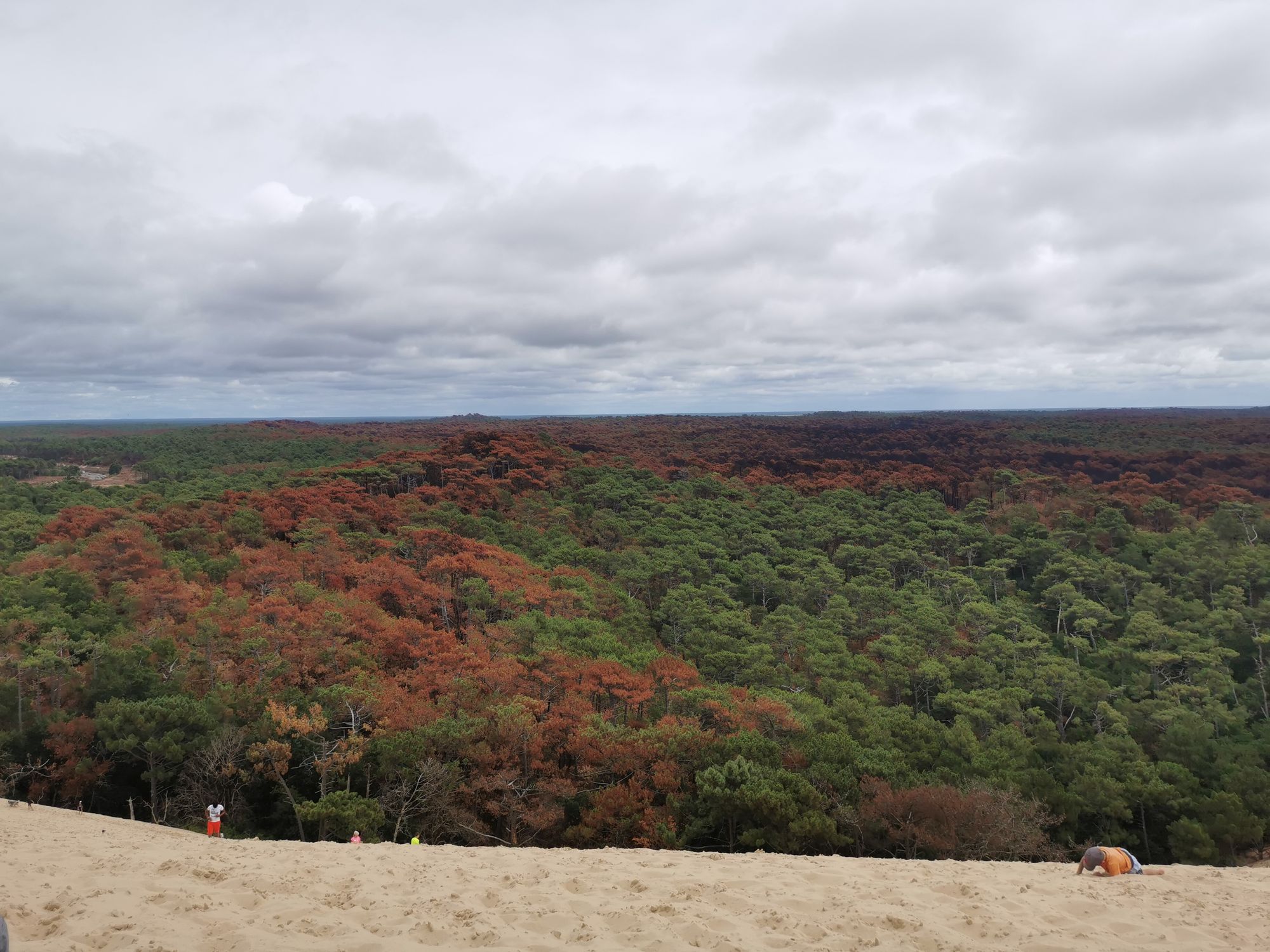
The weight of the situation continued to bear down on me for quite a while. Only when I crossed the French-Spanish border in Irún did the lightness come back into my life. Every border crossing is something special. It was a new beginning and I had to think of the many kilometers I had traveled up to that point, the people I had met and the intense experiences. I looked back on the past weeks with humility, and slowly the feeling that a large part of my journey was already behind me began to emerge.
The problem with the coast was still the same. The crowds and all the commercialism deterred me from going further along the ocean. I was drawn back inland, back to the mountains. And so I decided to set out on the Camino Francés, probably the most famous part of the Way of St. James.
Between me and the Camino, however, was a mountain range that posed new challenges with its steep climbs. Soaked with sweat, I arrived at the ridge in the evening. I would have done anything for a refreshing shower at that moment. But there was no hope of that. At least that's what I thought. Because shortly before I arrived on the ridge, an elderly man invited me to do just that. He stood at his garden door and asked if there was anything I needed. I am always overwhelmed by the helpfulness and hospitality of the people when I am on the road with my bike. And I am surprised by the ease with which I accept the help.
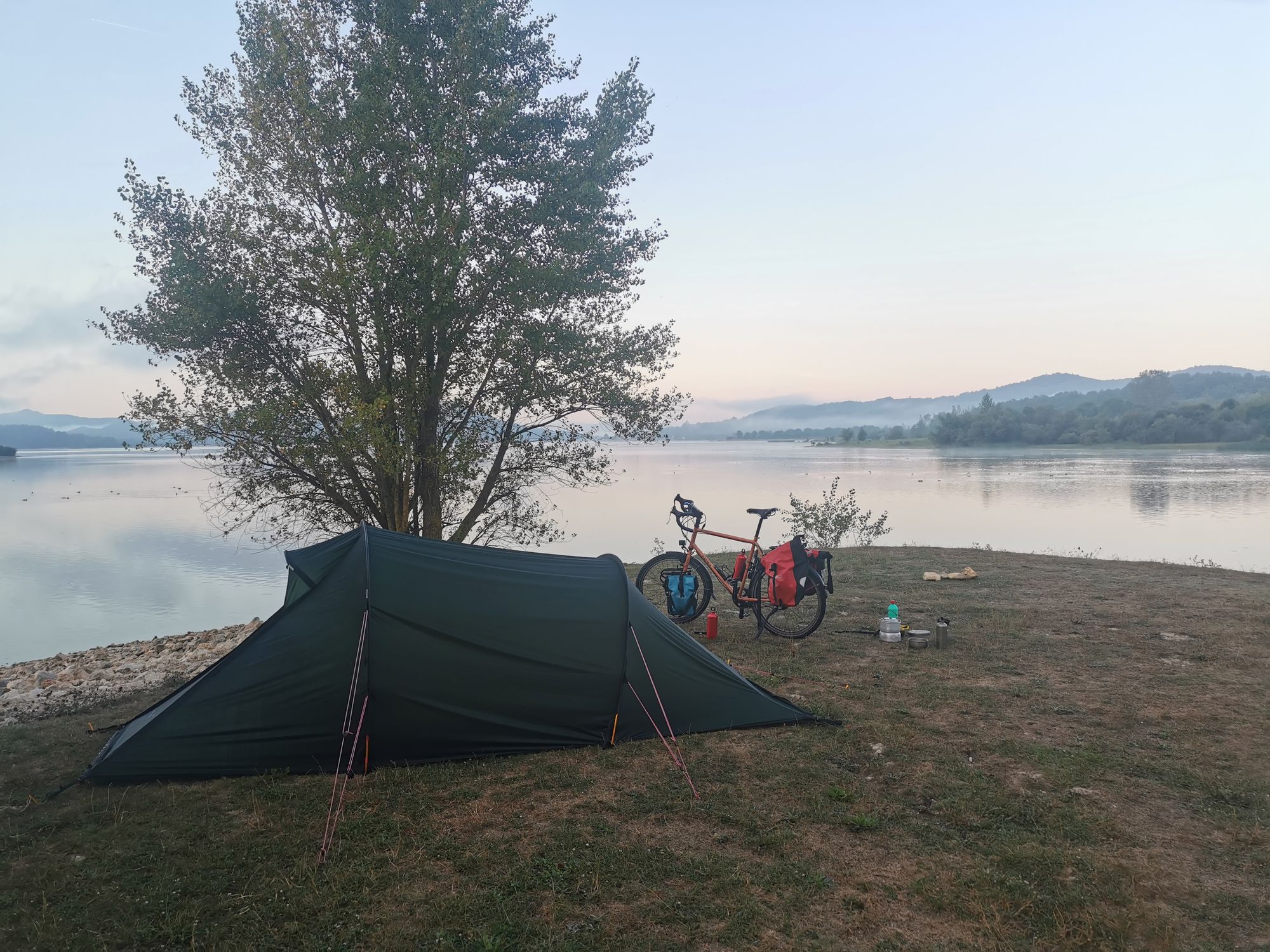
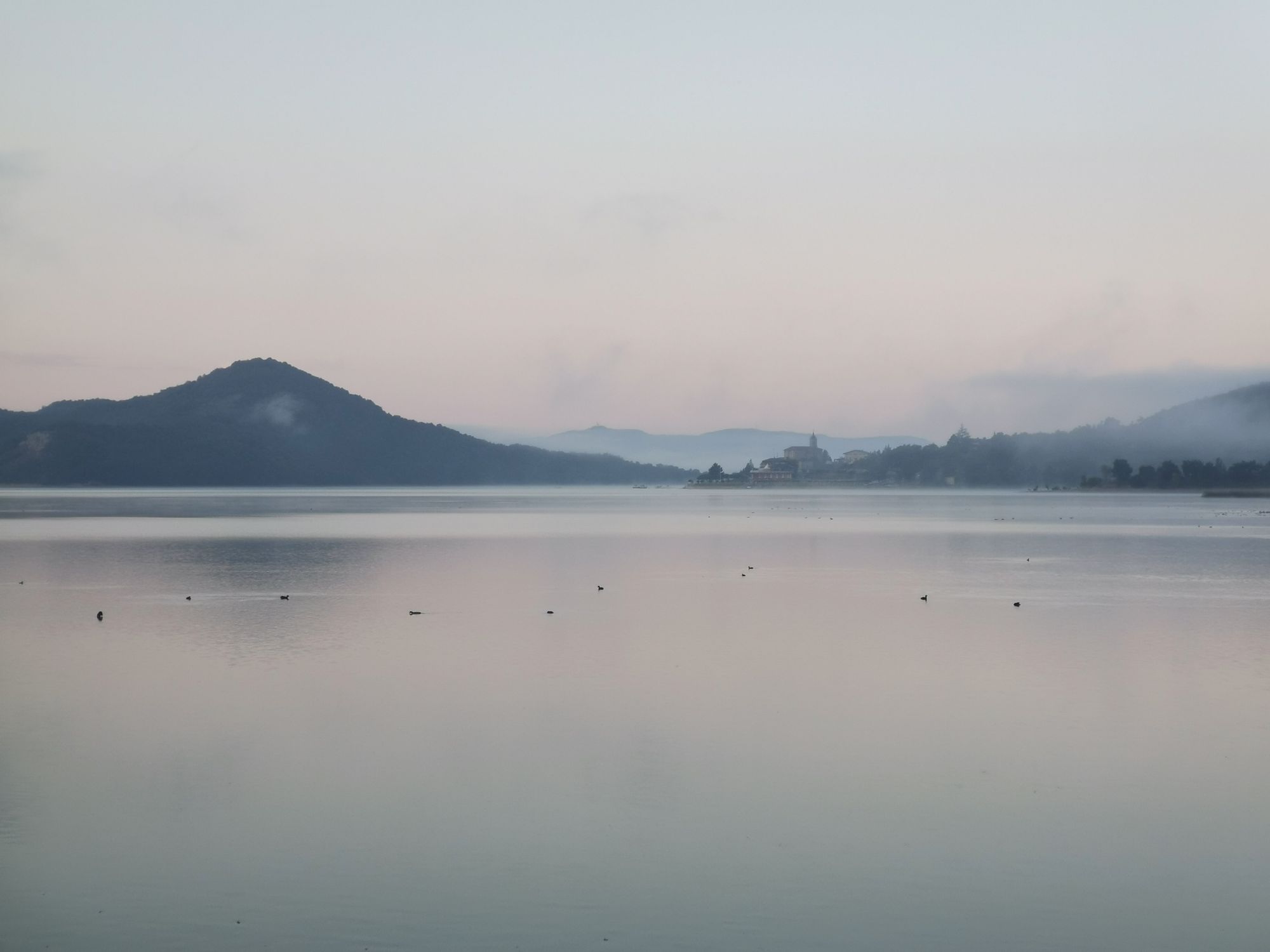
After a short time, I was suddenly on the Camino de Santiago. Only here I noticed that I was, in fact, on the Camino the whole time. On my own Camino. Again and again I saw the Jacob’s shell on the roadside - small and inconspicuous - you had to look closely to discover it. But from here on, the emblem of the pilgrimage could no longer be overlooked. It grew to gigantic size and met me in ever greater numbers. It was not long before I met the first pilgrims and heard the first "Buen Camino", a greeting that would accompany me for the next 600 kilometers.
Like the landscape, the people I met here also changed. Suddenly, I was no longer the only one who moved around using only his physical strength. Suddenly I was the one who used aids to do so. I almost felt as if I were cheating.
After a while, I realized that I was meeting people here who were looking for more than just the physical challenge. I quickly realized that everyone here was on the road with their own story. That's always the case in life, of course, but here it was a topic of discussion. People talked about it. I was touched by the encounters, and it stimulated me to think more about my own path as well. It was a few kilometers before León when I met Verena and Julian. I told them my story and for the first time since I was on the road, I realized that I was reaching other people with my journey - that I was touching other people with it.
It set a process in motion that continues to this day. Thanks to people like Julian and Verena, I was able to gather the courage and confidence to write about it now. Through encounters like these, my journey took on a different shape. It was no longer just a journey by bicycle across Europe. It became a spiritual journey of discovery, directed more inward than outward. More and more often, I began to pause along the way and realize what I was actually doing.
There was this path that led from Leipzig to the Spanish inland. I have followed this path now for almost 3000 kilometers. What was it about? What drove me to take on this journey? What did this path do to me?
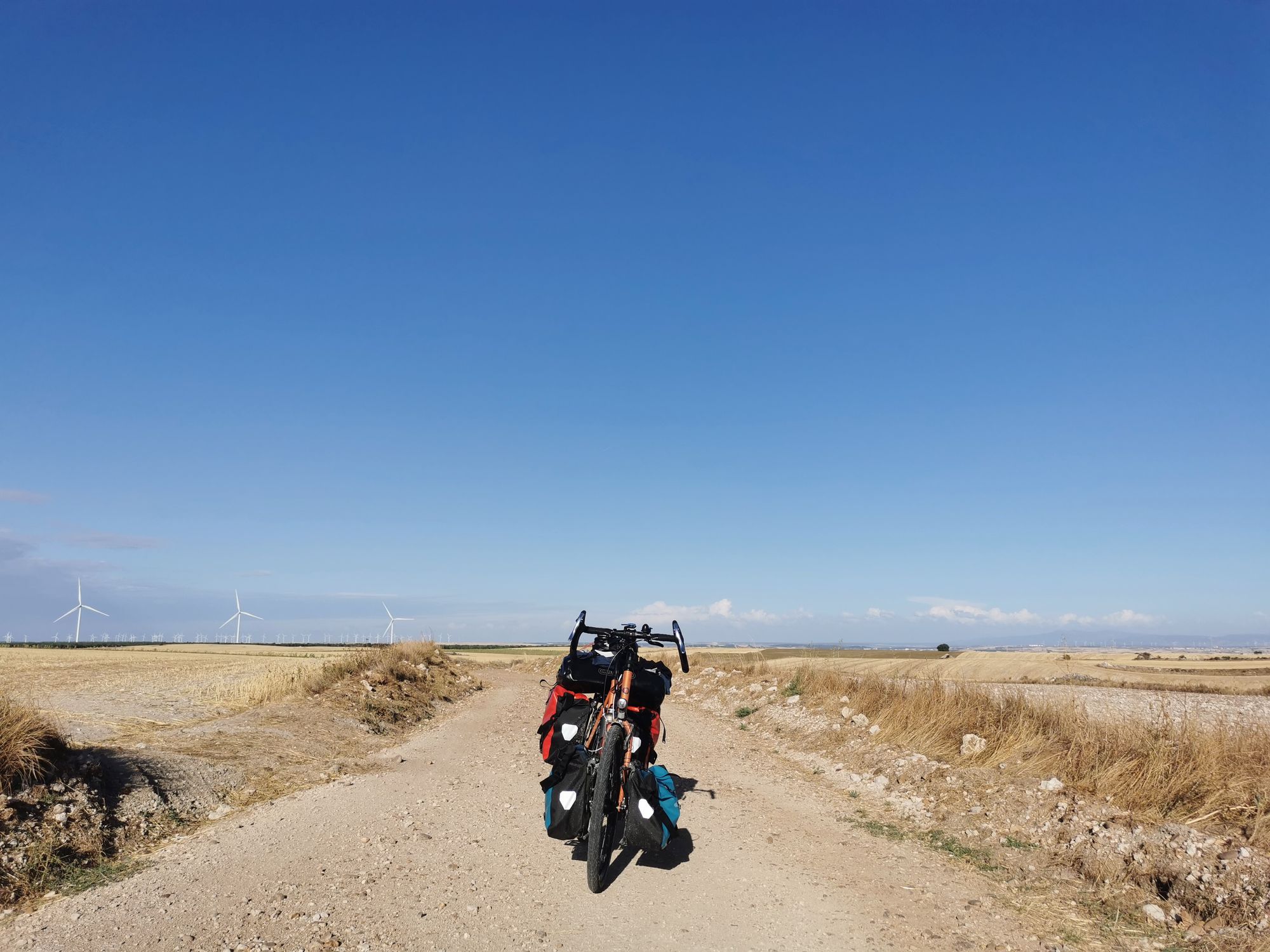
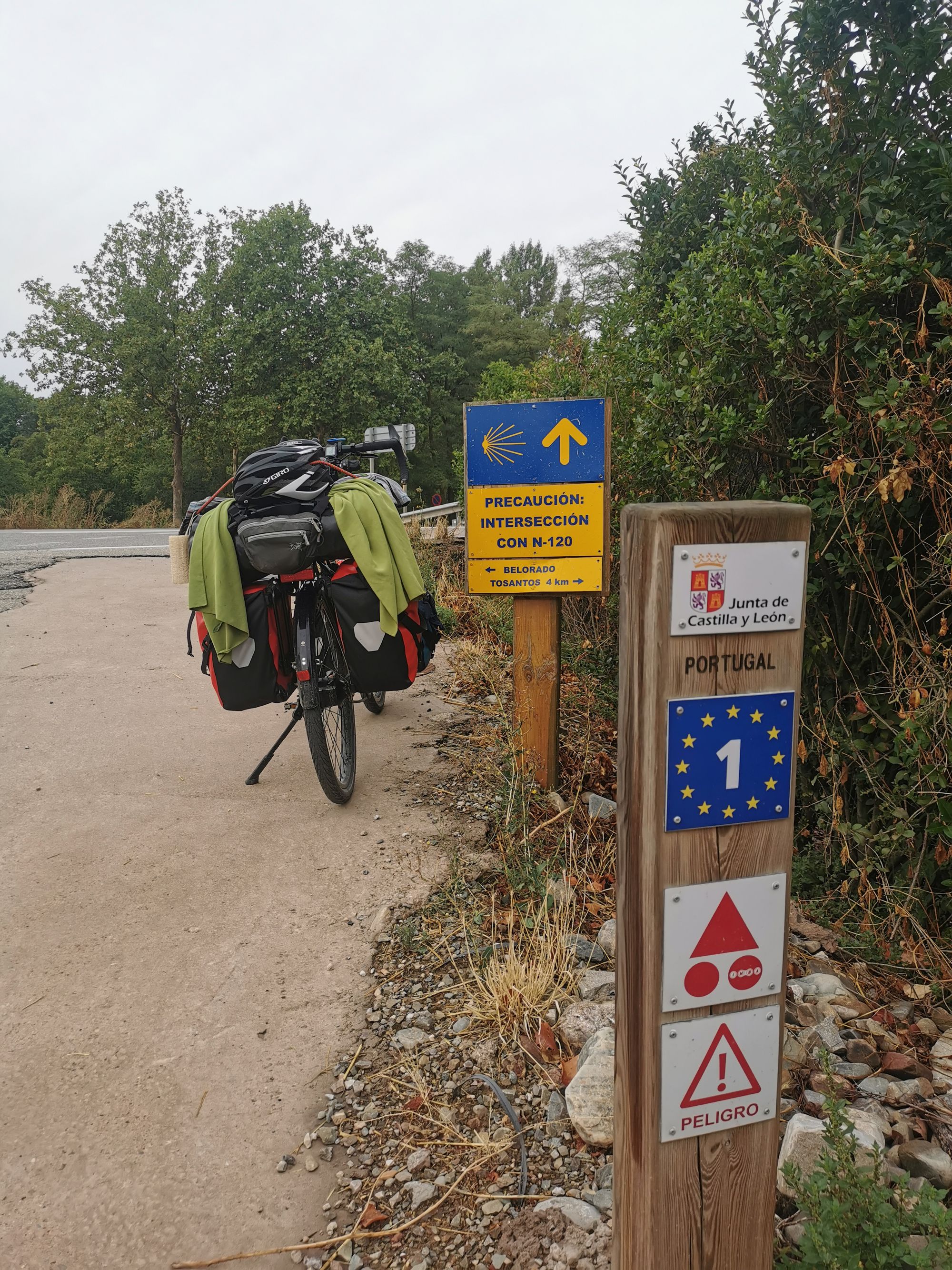
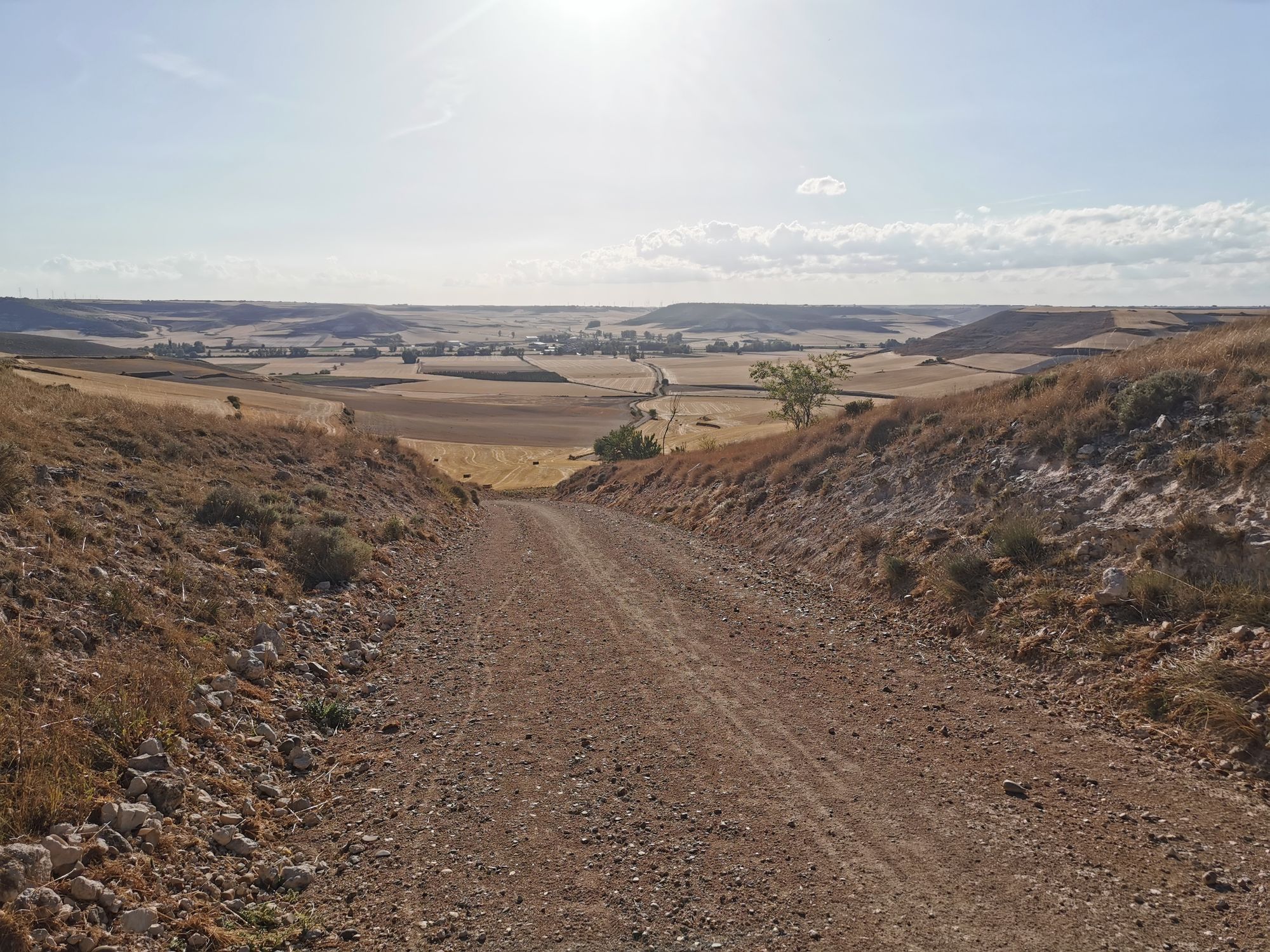
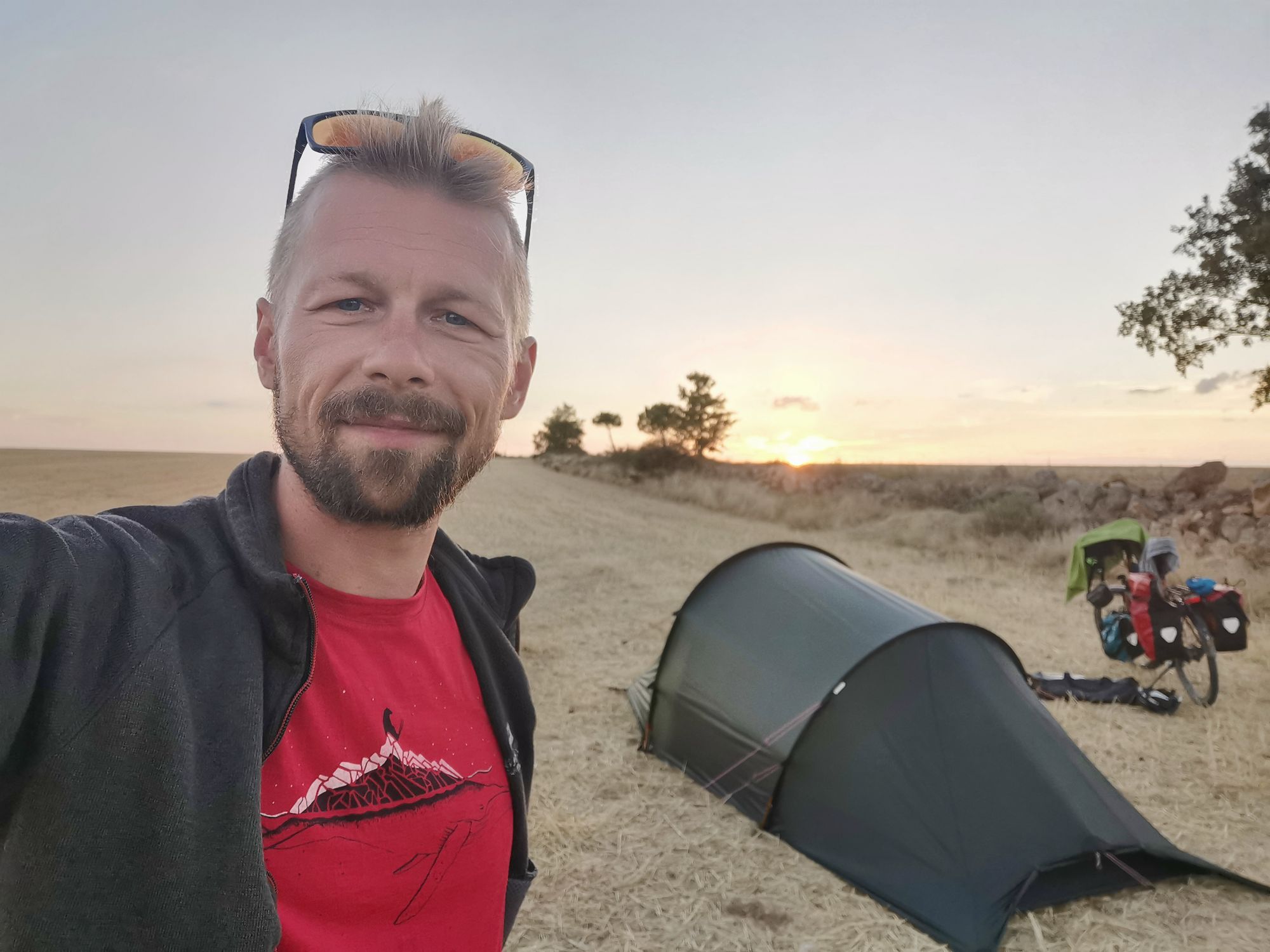
What follows now is a thicket of thoughts from the Camino de Santiago, which intertwine with thoughts of the last weeks and days. These are the questions that I've been trying to get to the bottom of since I've been on the road. Questions that I try to answer since I write about it:
What's it all about for you? Isn't it about what's happening on the inside? You've been thinking a lot about the outside lately. Why? Isn't that kind of superficial to you? Aren't you somehow missing the higher meaning in the whole thing?
I get it, you don't need a greater sense of purpose to ride your bike around the world. I know, you can't imagine anything more beautiful. But what are you writing about here? Think, Martin! What was it that got you in here? What was it that brought you out again? What is it that makes it so difficult for you to talk about it? What was it that brought tears of joy and sadness to your eyes back on the Camino?
And there it is all of a sudden. Call it what you will: depression, isolation, the desire to no longer want to live.
I never thought in my life that I would ever feel so alive again. I started down the road to darkness when I decided to deny myself my own path in life. After that, everything fell apart and only after years, when I began to accept who I am and when I realized that there is no other way for me than this, I suddenly found myself among the living again.
I have taken a lot during the years of darkness. Now it is time to give.
Erkenntnisse am Jakobsweg
Mein Weg von Deutschland nach Portugal führte mich von Bordeaux an den Atlantischen Ozean, an dessen Ufern ich die spanische Grenze überquerte. Das Unterwegssein wurde zur Routine und damit begann die Reise in mein Inneres.
Ich konnte es kaum erwarten, aufzubrechen. Vor mir lag der Atlantik – ein wichtiger Meilenstein auf meiner Reise von Deutschland nach Portugal. Über Wege, die mit dem Lineal in die Landschaft gezogen wurden, kam ich meinem großen Zwischenziel immer näher, nachdem ich meine Reise von Bordeaux aus fortsetze. Ich war wieder auf der Jagd nach dem Horizont. Vor meinem geistigen Auge sah ich mich bereits an kilometerweiten Stränden in der Sonne sitzen und mich zur Abkühlung in die Wellen werfen, wann immer mir der Sinn danach stand. Die Realität sah anders aus.
Ich erreichte das Ufer des Atlantik in Lacanau Océan. Anstatt menschenleerer Strände, fand ich einen Ort am Ozean, der von einem Teppich aus Menschen überzogen war. Lacanau war das Gegenteil von dem, was ich mir vorstellte. Es war wie in einem Freizeitpark voller Lichter und Geräusche, die nur dafür da waren, meine Aufmerksamkeit auf sich und mir das Geld aus der Tasche zu ziehen. Ein paar Kilometer weiter wurde es ruhiger, doch die Strandromantik, die ich mir erhoffte, blieb aus. Vom Radweg in den Pinienwäldern bis zum eigentlichen Strand lagen oft weite Dünenlandschaften, sodass ich das Meer nur selten zu Gesicht bekam. Hinzu kam, dass der Sand so ziemlich allen beweglichen Teilen meines Fahrrads ordentlich zusetzte. Das Knirschen und Knacken in meiner Kette fügt mir noch heute Schmerzen zu, wenn ich daran denke. Nach einer Weile gewöhnte ich mich an den Gedanken, dass dieser Teil meiner Reise anders werden sollte, als ich ihn mir zuvor ausmalte.

Woran ich mich nicht gewöhnen konnte, waren die Auswirkungen der Waldbrände. Meine schlimmsten Befürchtungen blieben aus. Ich wurde nicht von den Feuern überrascht oder auf einem abgelegenen Waldweg von ihnen eingeschlossen. Ich musste meine Route nur leicht anpassen, um Sperrgebiete zu umfahren. Stattdessen kam ich, als alles schon vorüber war. Was blieb, waren die trostlosen Überreste einer Katastrophe. Meilenweit verbrannte Erde und verkohlte Bäume, immer begleitet vom säuerlichen Geruch feuchter Asche. Ich kam nach kurzer Zeit zur Dune du Pilat, der größten Sanddüne Europas. Auch hier wüteten die Waldbrände noch ein paar Tage vor meiner Ankunft. Doch statt betroffener oder schockierter Menschen traf ich dort auf Touristen, denen man keineswegs etwas anmerkte. Mit absurder Ausgelassenheit pilgerten sie auf die Düne, um ein Foto vom Ozean zu machen. Unzählige Fotos ein und desselben Motivs. Alles, was ich sah, war eine Menschentraube, die in stiller Übereinkunft der zerstörten Natur den Rücken zuwandte, um sich auf die schönen Dinge im Leben zu konzentrieren. Ich hatte zu kämpfen, dabei nicht in Zynismus zu verfallen.

Das Gewicht der Situation lastete noch eine ganze Weile auf mir. Erst als ich in Irún die französisch-spanische Grenze überschritt, kam die Leichtigkeit zurück in mein Leben. Jeder Grenzübergang ist etwas Besonderes. Es war ein Neuanfang und ich musste an die vielen Kilometer denken, die ich bis dahin zurückgelegt hatte, die Menschen, die ich getroffen und die intensiven Erfahrungen, die ich bis dahin gemacht hatte. Mit Demut blickte ich auf die vergangenen Wochen zurück und langsam zeichnete sich das Gefühl ab, dass ein Großteil meiner Reise bereits hinter mir lag.
Das Problem mit der Küste war immer noch dasselbe. Die vielen Menschen und der ganze Kommerz schreckte mich ab, weiter entlang des Ozeans zu fahren. Es zog mich zurück ins Landesinnere, zurück zu den Bergen. Und so beschloss ich, mich auf den Weg zum Camino Francés zu begeben, dem wohl bekanntesten Teil des Jakobsweges.
Zwischen mir und dem Camino lag jedoch eine Bergkette, die mich mit ihren steilen Anstiegen vor neue Herausforderungen stellte. Von Schweiß durchnässt kam ich am Abend auf dem Bergkamm an. Was hätte ich nicht in diesem Moment für eine erfrischende Dusche getan? Doch darauf bestand keine Hoffnung. Das dachte ich zumindest. Denn kurz bevor ich auf dem Bergkamm ankam, lud mich ein älterer Mann genau dazu ein. Er stand an seiner Gartentür und fragte, ob mir etwas fehlte. Ich bin immer wieder überwältigt von der Hilfsbereitschaft und der Gastfreundlichkeit der Menschen, wenn ich mit dem Fahrrad unterwegs bin. Und ich bin überrascht von der Selbstverständlichkeit, mit der ich diese Hilfe annehme.


Nach kurzer Zeit war ich plötzlich auf dem Jakobsweg. Erst hier fiel mir auf, dass ich im Prinzip die ganze Zeit auf dem Jakobsweg war. Auf meinem Jakobsweg. Immer wieder sah ich die Jakobsmuschel am Wegesrand – klein und unscheinbar – man musste schon genau hinsehen, um sie zu entdecken. Doch ab hier war das Wappenzeichen des Pilgerpfades nicht mehr zu übersehen. Es wuchs auf gigantische Größe an und begegnete mir immer häufiger.
Es dauerte nicht lange, bis ich den ersten pilgernden Menschen begegnete und das erste »Buen Camino« zu hören bekam, eine Begrüßung, die mich für die nächsten 600 Kilometer begleiten sollte.
Wie die Landschaft änderten sich auch die Menschen, denen man hier begegnete. Plötzlich war ich nicht mehr der einzige, der sich nur mit seiner Körperkraft fortbewegte. Plötzlich war ich derjenige, der Hilfsmittel dafür verwendete. Ich kam mir dabei fast so vor, als würde ich schummeln.
Nach einer Weile begriff ich, dass ich hier Menschen begegnete, die auf der Suche nach mehr waren, als nur der körperlichen Herausforderung. Mir wurde schnell klar, dass hier jeder mit seiner eigenen Geschichte unterwegs war. Das ist natürlich immer so im Leben, aber hier wurde es thematisiert. Man sprach darüber. Ich war von den Begegnungen berührt und es regte mich dazu an, auch mehr über meinen eigenen Weg nachzudenken. Es war ein paar Kilometer vor León, als ich Verena und Julian kennenlernte. Ich erzählte Ihnen meine Geschichte und das erste Mal seitdem ich unterwegs war, realisierte ich, dass ich mit meiner Reise andere Menschen erreiche – dass ich andere Menschen damit berührte.
Es setzte einen Prozess in Gang, der bis heute anhält. Menschen wie Julian und Verena habe ich es zu verdanken, dass ich den Mut und das Selbstvertrauen fassen konnte, um jetzt darüber zu schreiben. Durch Begegnungen wie diese nahm meine Reise eine andere Form an. Es war nun nicht mehr nur eine Reise mit dem Fahrrad quer durch Europa. Es wurde eine spirituelle Entdeckungsreise, die sich vielmehr nach Innen als nach Außen richtete. Immer häufiger begann ich, unterwegs innezuhalten und zu realisieren, was ich eigentlich tat.
Es gab da diesen Weg, der von Leipzig bis ins spanische Inland führte. Ich folgte diesem Weg jetzt seit fast 3000 Kilometern. Was war es? Was trieb mich an, diese Reise auf mich zu nehmen? Was machte dieser Weg mit mir?




Was nun folgt, ist ein Gestrüpp aus Gedanken vom Jakobsweg, die sich mit Gedanken der letzten Wochen und Tage verästeln. Es sind die Fragen, denen ich auf den Grund zu gehen versuche, seitdem ich unterwegs bin. Fragen, die ich versuche zu beantworten seit dem ich darüber schreibe:
Worum geht's dir eigentlich? Geht es nicht um das, was drinnen passiert? Du hast in letzter Zeit ganz schön viel über das Außen nachgedacht. Warum? Ist dir das nicht irgendwie oberflächlich? Fehlt dir in der ganzen Sache nicht irgendwie der höhere Sinn?
Ich verstehe schon, du brauchst keinen größeren Sinn, um mit dem Fahrrad um die Welt zu fahren. Ich weiß schon, du kannst dir nichts Schöneres vorstellen. Doch über was schreibst du hier? Denk nach, Martin! Was hat dich hier hereingebracht? Was war es, das dich wieder herausgebracht hat? Was macht dir solche Schwierigkeiten, darüber zu reden? Was war es, das dir damals am Camino Tränen der Freude und Trauer zugleich in die Augen trieb?
Und da ist es plötzlich. Nennt es, wie ihr wollt: Depression, Isolation, der Wunsch, nicht mehr leben zu wollen.
Ich hätte nie im Leben geglaubt, dass ich mich jemals wieder so lebendig fühlen würde. Als ich beschloss, mir meinen eigenen Lebensweg zu versagen, trat ich den Weg in die Dunkelheit an. Danach brach alles zusammen und erst nach Jahren, als ich begann, zu akzeptieren, wer ich bin und als ich realisierte, dass es für mich keinen anderen Weg als diesen gibt, fand ich mich plötzlich wieder unter den Lebenden.
Ich habe in den Jahren der Dunkelheit viel genommen. Nun wird es Zeit zu geben.